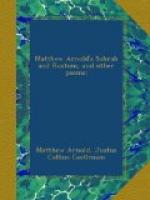Rugby Chapel (1857), one of Arnold’s best-known and most characteristic productions, was written in memory of his father, Dr. Thomas Arnold, famous as the great head-master at Rugby. Dr. Arnold was born at East Cowes in the Isle of Wight, June 13, 1795, and as a boy was at school at Warminster and Winchester. In 1811 he entered Corpus Christi College, Oxford, and having won recognition as a scholar, was awarded a fellowship of the Oriel in 1815. Three years later he settled at Laleham, where, in 1820, he married Mary Penrose, daughter of Justice Penrose, and where, two years later, was born Matthew, who was destined to win marked distinction among English men of letters. In 1827 he was elected head-master at Rugby, and shortly afterward began those important reforms which have placed him among the greatest educators of his century. Chief among his writings is his History of Rome, published in several volumes. In 1841 he was appointed Regius Professor of History at Oxford. He died very suddenly on Sunday, June 12, 1842, and on the following Friday his remains were interred in the chancel of Rugby Chapel, immediately under the communion table. [210]
In his poem Arnold has drawn a vivid picture of a strong, helpful, hopeful, unselfish soul, cheering and supporting his weaker comrades in their upward and onward march—a picture of the guide and companion of his earlier years; and in so doing he has preserved his father’s memory to posterity in a striking and an abiding way.
=1-13=. Note carefully the tone of these introductory lines, and determine the poet’s purpose in opening the poem in this mood. The picture inevitably calls to mind Bryant’s lines, The Death of Flowers.
=16. gloom=. The key-word to the preceding lines. Explain why it calls to mind the poet’s father. Keats makes a similar use of the word forlorn in his Ode to the Nightingale.
“...
forlorn.
Forlorn!
the very word is like a bell
To
toll me back from thee to my sole self.”
=30-33=. Discuss the figure as to its aptness.
=37. shore=. A word common to hymns.
=38-57=. Discuss the poet’s idea of the future life as set forth in these lines. Can you think of any other author or authors who have held a like view?
=58-59=. The poet asks this question only to answer it in the lines following. Compare and contrast the two classes of men spoken of; their aims in life and their achievements. Why is the path of those who have chosen a “clear-purposed goal” pictured so difficult? Who are they that start well, but fall out by the wayside? [211]
=90-93=. Compare with Byron’s description of a storm in the Alps, Canto III, Childe Harold.
“Far
along,
From
peak to peak, the rattling crags among
Leaps
the live thunder.”




